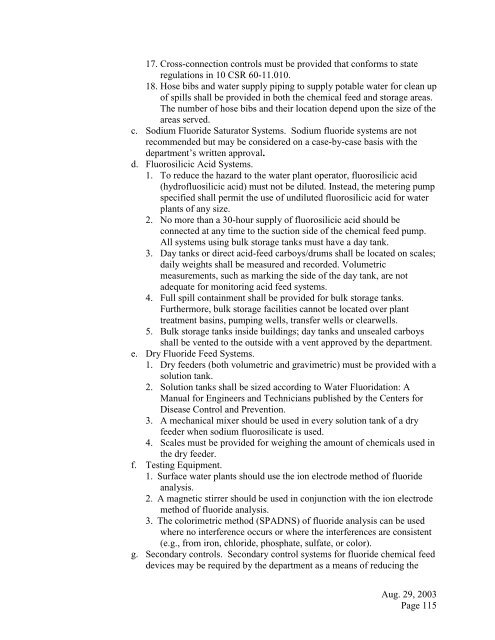Design Guide for Community Water Systems - The Water, Sanitation ...
Design Guide for Community Water Systems - The Water, Sanitation ...
Design Guide for Community Water Systems - The Water, Sanitation ...
You also want an ePaper? Increase the reach of your titles
YUMPU automatically turns print PDFs into web optimized ePapers that Google loves.
17. Cross-connection controls must be provided that con<strong>for</strong>ms to stateregulations in 10 CSR 60-11.010.18. Hose bibs and water supply piping to supply potable water <strong>for</strong> clean upof spills shall be provided in both the chemical feed and storage areas.<strong>The</strong> number of hose bibs and their location depend upon the size of theareas served.c. Sodium Fluoride Saturator <strong>Systems</strong>. Sodium fluoride systems are notrecommended but may be considered on a case-by-case basis with thedepartment’s written approval.d. Fluorosilicic Acid <strong>Systems</strong>.1. To reduce the hazard to the water plant operator, fluorosilicic acid(hydrofluosilicic acid) must not be diluted. Instead, the metering pumpspecified shall permit the use of undiluted fluorosilicic acid <strong>for</strong> waterplants of any size.2. No more than a 30-hour supply of fluorosilicic acid should beconnected at any time to the suction side of the chemical feed pump.All systems using bulk storage tanks must have a day tank.3. Day tanks or direct acid-feed carboys/drums shall be located on scales;daily weights shall be measured and recorded. Volumetricmeasurements, such as marking the side of the day tank, are notadequate <strong>for</strong> monitoring acid feed systems.4. Full spill containment shall be provided <strong>for</strong> bulk storage tanks.Furthermore, bulk storage facilities cannot be located over planttreatment basins, pumping wells, transfer wells or clearwells.5. Bulk storage tanks inside buildings; day tanks and unsealed carboysshall be vented to the outside with a vent approved by the department.e. Dry Fluoride Feed <strong>Systems</strong>.1. Dry feeders (both volumetric and gravimetric) must be provided with asolution tank.2. Solution tanks shall be sized according to <strong>Water</strong> Fluoridation: AManual <strong>for</strong> Engineers and Technicians published by the Centers <strong>for</strong>Disease Control and Prevention.3. A mechanical mixer should be used in every solution tank of a dryfeeder when sodium fluorosilicate is used.4. Scales must be provided <strong>for</strong> weighing the amount of chemicals used inthe dry feeder.f. Testing Equipment.1. Surface water plants should use the ion electrode method of fluorideanalysis.2. A magnetic stirrer should be used in conjunction with the ion electrodemethod of fluoride analysis.3. <strong>The</strong> colorimetric method (SPADNS) of fluoride analysis can be usedwhere no interference occurs or where the interferences are consistent(e.g., from iron, chloride, phosphate, sulfate, or color).g. Secondary controls. Secondary control systems <strong>for</strong> fluoride chemical feeddevices may be required by the department as a means of reducing theAug. 29, 2003Page 115
















